
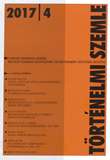 STUDIES
STUDIES
Levente Nagy: Martyr or Adventurer? Sava Branković and the Romanian Reformation in Transylvania during the Principality of Mihály Apafi I 525
Antal András Kováts: Swiss in the Flow of Hungarian History, 1867–1990 543
Attila Simon: The Three Occupations of Kassa. Parallels and Morals 569
Péter Apor: The Misery of Alternative Democracy. Ideology, Political Language and the Possibilities of Opposition in Hungary, 1968–1973 591
WORKSHOP
Balázs Sudár: On the Cultural Historical Background of the Hungarian Word Turul 605
Dániel Bácsatyai: King Andrew II’s Envoys in England 621
Péter E. Kovács: Hungarian Banners in Venetian Hands 633
István Kádas: Cum sigillo nostro. Seal Usage in Late Medieval Sáros County 637
Elek Szaszkó: The Registry of the Revenues and Expenses of the Sződi Manor from 1517/1518 (Contributions to the possessions of the Gersei Pető family in the southern region of the Great Hungarian Plain) 655
Barna Ábrahám: „With other nations like Saxons…” Interactions between Orthodoxy and Lutheranism in Transylvania in post-1867 Hungary 683
REVIEW ARTICLE 691
COMMEMORATION 699
STUDIES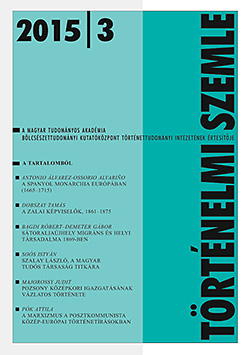
Antonio Álvarez-Ossorio Alvariño: Between Conservation and Succession: the Spanish Monarchy in Europe (1665–1715) 351
Tamás Dobszay: The MPs of Zala, 1861–1875 363
Róbert Bagdi–Gábor Demeter: The Characteristics of the Indigenous and Local Societies of Sátoraljaújhely Based on the Results of the Census in 1869 381
István Soós: László Szalay, Secretary of the Hungarian Scientifi c Society 411
WORKSHOP
Judit Majorossy: Sketching the Urban Administration of a Free Royal Town at the Border of the Kingdom of Hungary (Introduction to the “Archontology of Medieval Pressburg” in Process) 441
Attila Pók: Marxism in Post-Communist Central European Historical Writing 471
LIFE AT THE INSTITUTE 487
DEBATE 507
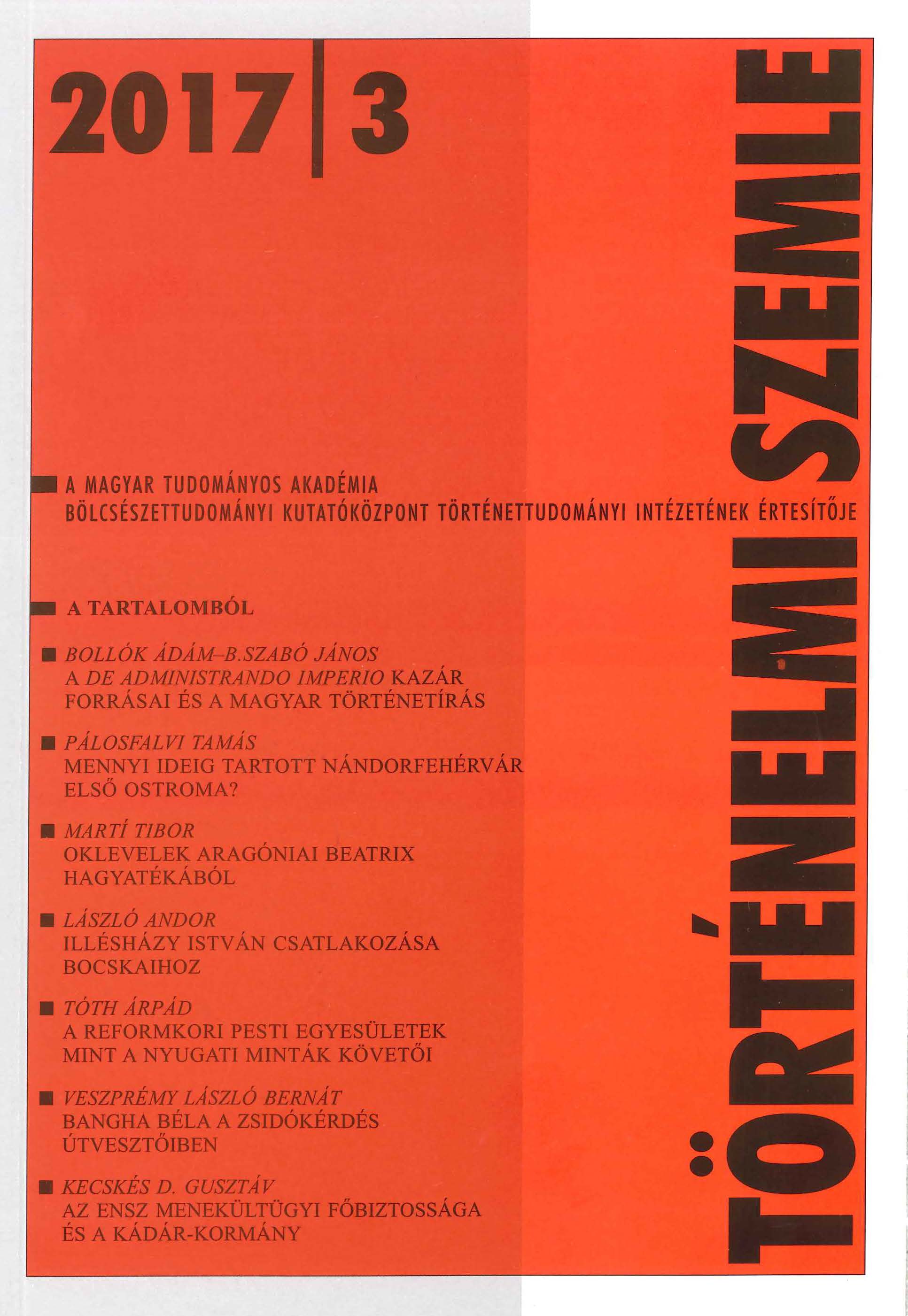 STUDIES
STUDIES
Ádám Bollók–János B. Szabó: How Did the Hypothesis on the Khazar Origin of the Information Preserved in Chapter 38 of De administrando imperio Disappear from Hungarian Historiography. A Historiographical Case Study 347
Andor László: Why István Illésházy Joined István Bocskai (1605) 379
Árpád Tóth: ’Aping’ or adaptation? The Pest voluntary societies of early 19th century as followers of Western patterns 399
DEBATE
Tamás Pálosfalvi: How Long Did the Siege of Belgrade Last in 1440?
Refl ections on an „extremely obscure” event 417
WORKSHOP
László Bernát Veszprémy: An Old-fashioned Jesuit anti-Judaist. Béla Bangha SJ in the Labyrinth of the Jewish Question 439
Gusztáv Kecskés D.: Relations between the Offi ce of the UN High Commissioner for Refugees (UNHCR) and the Kádár Administration during the Hungarian Refugee Crisis of 1956 463
DOCUMENTS
Tibor Martí: Unpublished Charters from the legacy of Beatrice of Naples 491
T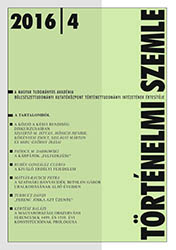 HE COMMON GOOD IN THE DISCOURSES OF THE LATE ANCIEN RÉGIME IN HUNGARY
HE COMMON GOOD IN THE DISCOURSES OF THE LATE ANCIEN RÉGIME IN HUNGARY
István M. Szijártó: The Concept of Common Good in Early Modern Political Discourse 499
Henrik Hőnich: “Public Happiness” and “Common Good”. On the Terminology of The True Patriot by Zsigmond Osvald 505
Zsolt Kökényesi: The Training of Useful Citizens. The Relations between Common Good and Education in the 18th-Century Habsburg Monarchy 519
Márton Szilágyi: The Common Good in György Bessenyei’s Novel Tariménes útazása (The Journey of Tarimenes) (1804) 533
György Miru: Moral Values and Divisible Goods in the Political Thinking of the “Reform Era” 541
STUDIES
Patrice M. Dabrowski: “Discovering” the Carpathians. Encounters between Lowlanders and Highlanders in the 19th Century 555
Rubén González Cuerva: “The prodigious Transylvanian prince”. The “long war” against the Ottoman Empire (1593–1606) in the Mirror of the relaciones de sucesos 565
WORKSHOP
Petra Mátyás-Rausch: The Mining Region of Szatmár in the First Years of Gábor Bethlen’s Rule (1613–1619) 585
Dávid Turbucz: “Francis Joseph Sent a Message”. Imperial Birth- and Namedays during World War I 603
Adrienn Kapitány: Traffi c-Related Proposals in the Commercial Elaborations of the National Committee of 1828–1830 615
DOCUMENTS
Balázs Kertész: The Prologue of the 1499 and 1518 Constitutions of the Observant Franciscans in Hungary 643
STUDIES
Károly Goda: „Ecce panis angelorum”. Medieval Corpus Christi Festivities and Processions in Vienna and Buda in a Central European Perspective 183
Péter Tusor: The Primate, the Ban and the Court of Vienna (1663–1664) 219
Orsolya Völgyesi: The Generation of László Szalay in the Lure of Kölcsey 251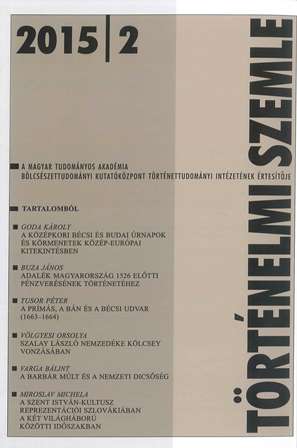
WORKSHOP
Viktória Kovács: The Background to the Landowning of the Premonstratensians of Lelesz at Szalóka 265
János Buza: The Draw Bench Thrown into the Danube. On Minting in Hungary before 1526 281
György Kurucz: Interests of Allied Powers, Protestant Sympathies, Military Realities: Prince Rákóczi’s Freedom Fight and the English Diplomatic Mediation 299
Bálint Varga: The Barbarian Past and the Glory of the Nation 319
Miroslav Michela: „A Home Should Be a Home to All Its Sons”. Cultural Representations of the Cult of Saint Stephen in Slovakia during the Interwar Period 333
Géza Pálffy: The Century of Ruptures and Compromises: The History of the Kingdom of Hungary in the Seventeenth Century from a New Perspective 51
Gábor Erdődy: László Szalay the Politician 67
Iván Zoltán Dénes: Gyula Szekfű’s Image of Gábor Bethlen 97
WORKSHOP
Márton Szilágyi: To Bear the Unbearable. The Prison-World of the Convicts of the Martinovics Conspiration 121
Iván Halász: Polish City-states under International Supervision in Pre-1939 Europe: Cracow and Danzig as Free Cities 131
REVIEW ARTICLE
Researches on the Angevin Monarchy in Hungary from an Italian and French Perspective 155
COMMEMORATION 175
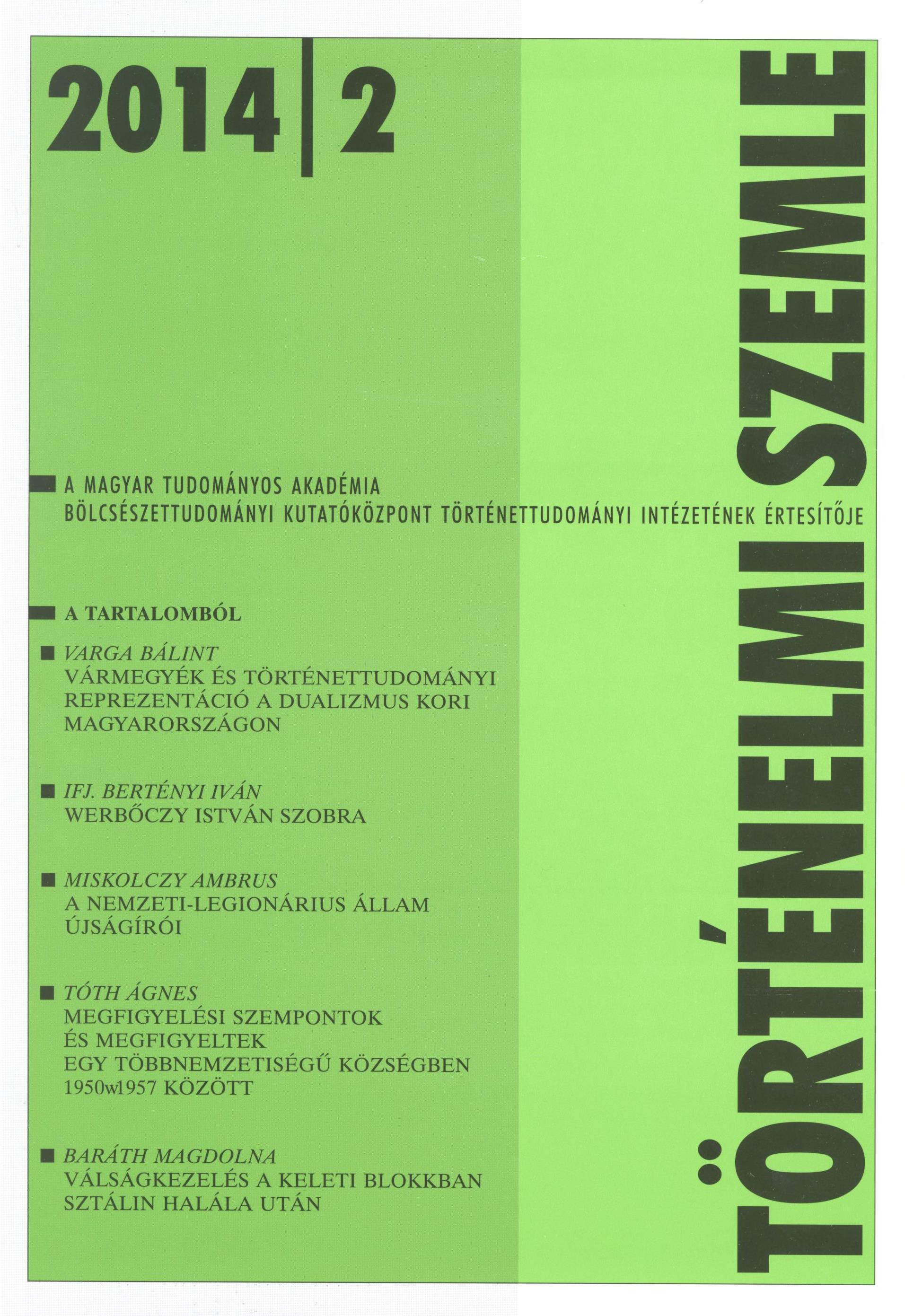 STUDIES
STUDIES
Bálint Varga: Counties and Historical Representation in Dualist Hungary 179
Iván Bertényi Jr.: There Stood for 37 Years. István Werbőczy’s Statue in Budapest 203
Ambrus Miskolczy: The Ideologist-Journalists of the National-Legionary State: the Philosopher and the Anti-Philosopher, the Historian and the Sociologist 231
Ágnes Tóth: Aspects of Political Surveillance and its Targets in a Multiethnic Village. Vaskút, 1950–1957 251
Magdolna Baráth: Confl ict Management in the Eastern Block after the Death of Stalin 269
WORKSHOP
Tibor Martí: „Did Pázmány Remain a Jesuit?” – The View of Cardinal Juan de Lugo from 1645 287
János Kalmár: János Pálffy and the „White Lady of Lőcse” 295
Verena Moritz: Some Thoughts about the Activity of Military Intelligence Services before World War I 307
Tibor Hajdu: The Plans of the Russian General Staff in 1910–1913 for an Attack against the Austro–Hungarian Monarchy and Germany 315
REVIEW ARTICLE
Boris Stojkovski: Serbian Historiography on the Medieval Hungarian–Serbi an Relations 329
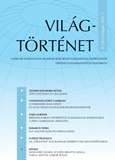 1956 as Refugee Crisis: New Perspectives (Stefano Bottoni) 331
1956 as Refugee Crisis: New Perspectives (Stefano Bottoni) 331
Studies
James P. Niessen: The Culture of Welcome and the January, 1957 Austrian Refugee Quota Proposal 337
Gusztáv D. Kecskés: The NATO and the 1956 Hungarian Refugees 357
András Nagy: The Special Committee on the Problem of Hungary, 1957–1958: Bang-Jensen’s Struggle with Eastern Spies and Western Bureaucrats 373
Nóra Deák: Operation Mercy: The (Not Impossible) Hungarian Refugee Resettlement Mission in the United States 397
Tiphaine Robert: The Return of 1956 Hungarian Refugees from Switzerland: Reasons and Interpretations of Returning Home in Propaganda Warfare 413
Attila Kovács: Yugoslavia and the 1956 Hungarian Refugee Crisis 433
András Lénárt: The Process of Growing up and Integration of the 1956 Emigrant Students into the Austrian Society 451
Balázs Balogh: The Social Integration of the Refugees of the 1956 Revolution in the USA 469
Book Reviews
Diplomatic Relations between Hungary and the Holy See, 1920–2015 (Petra Hamerli) 485
Cultural Diplomacy amid Diplomatic Tensions: France in Central and Eastern Europe, 1936‒1940, 1944‒1951 (Gusztáv D. Kecskés) 490
Studies from the Workshop of Russistics (Mária Bodor) 495
Page 5 of 14